Value Stream Analysis and its Strengths and Weaknesses
VerifiedAdded on 2023/01/17
|15
|5643
|75
AI Summary
This document discusses the concept of value stream analysis and its strengths and weaknesses. It explains how value stream analysis can be used to improve processes in healthcare organizations. The document also highlights the benefits and limitations of this analysis.
Contribute Materials
Your contribution can guide someone’s learning journey. Share your
documents today.

Discussions
Author Name:
University:
Author Name:
University:
Secure Best Marks with AI Grader
Need help grading? Try our AI Grader for instant feedback on your assignments.
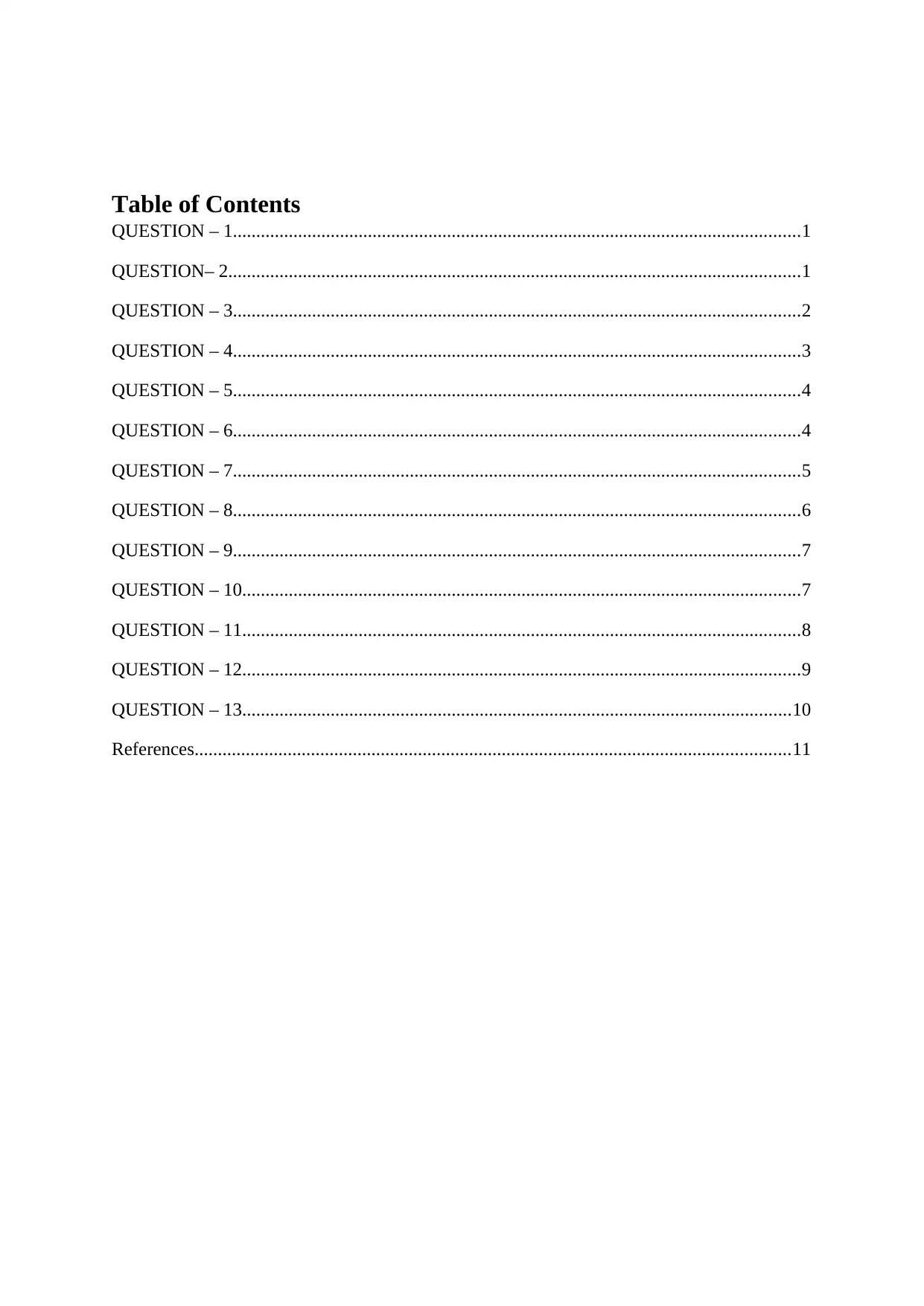
Table of Contents
QUESTION – 1..........................................................................................................................1
QUESTION– 2...........................................................................................................................1
QUESTION – 3..........................................................................................................................2
QUESTION – 4..........................................................................................................................3
QUESTION – 5..........................................................................................................................4
QUESTION – 6..........................................................................................................................4
QUESTION – 7..........................................................................................................................5
QUESTION – 8..........................................................................................................................6
QUESTION – 9..........................................................................................................................7
QUESTION – 10........................................................................................................................7
QUESTION – 11........................................................................................................................8
QUESTION – 12........................................................................................................................9
QUESTION – 13......................................................................................................................10
References................................................................................................................................11
QUESTION – 1..........................................................................................................................1
QUESTION– 2...........................................................................................................................1
QUESTION – 3..........................................................................................................................2
QUESTION – 4..........................................................................................................................3
QUESTION – 5..........................................................................................................................4
QUESTION – 6..........................................................................................................................4
QUESTION – 7..........................................................................................................................5
QUESTION – 8..........................................................................................................................6
QUESTION – 9..........................................................................................................................7
QUESTION – 10........................................................................................................................7
QUESTION – 11........................................................................................................................8
QUESTION – 12........................................................................................................................9
QUESTION – 13......................................................................................................................10
References................................................................................................................................11
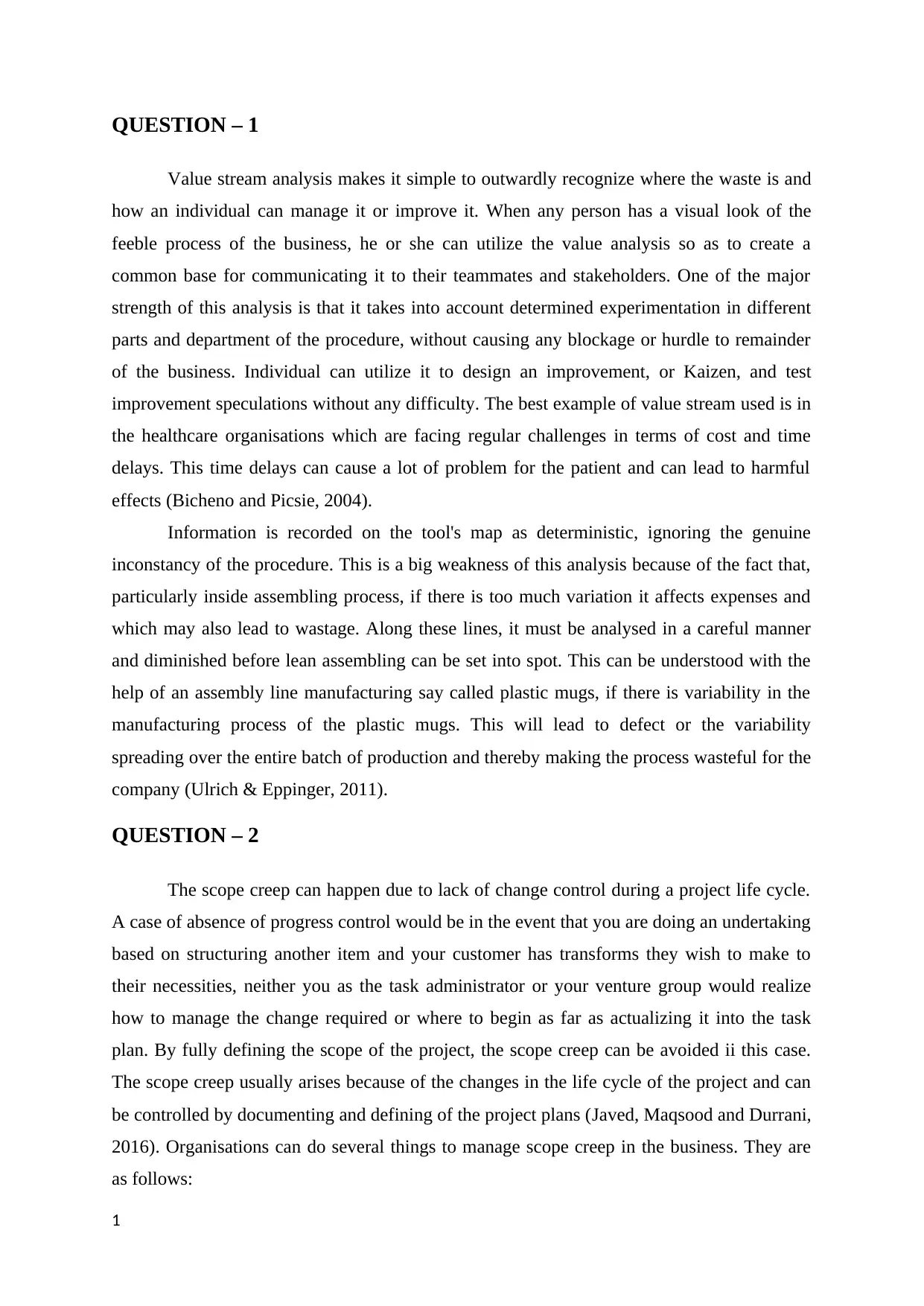
QUESTION – 1
Value stream analysis makes it simple to outwardly recognize where the waste is and
how an individual can manage it or improve it. When any person has a visual look of the
feeble process of the business, he or she can utilize the value analysis so as to create a
common base for communicating it to their teammates and stakeholders. One of the major
strength of this analysis is that it takes into account determined experimentation in different
parts and department of the procedure, without causing any blockage or hurdle to remainder
of the business. Individual can utilize it to design an improvement, or Kaizen, and test
improvement speculations without any difficulty. The best example of value stream used is in
the healthcare organisations which are facing regular challenges in terms of cost and time
delays. This time delays can cause a lot of problem for the patient and can lead to harmful
effects (Bicheno and Picsie, 2004).
Information is recorded on the tool's map as deterministic, ignoring the genuine
inconstancy of the procedure. This is a big weakness of this analysis because of the fact that,
particularly inside assembling process, if there is too much variation it affects expenses and
which may also lead to wastage. Along these lines, it must be analysed in a careful manner
and diminished before lean assembling can be set into spot. This can be understood with the
help of an assembly line manufacturing say called plastic mugs, if there is variability in the
manufacturing process of the plastic mugs. This will lead to defect or the variability
spreading over the entire batch of production and thereby making the process wasteful for the
company (Ulrich & Eppinger, 2011).
QUESTION – 2
The scope creep can happen due to lack of change control during a project life cycle.
A case of absence of progress control would be in the event that you are doing an undertaking
based on structuring another item and your customer has transforms they wish to make to
their necessities, neither you as the task administrator or your venture group would realize
how to manage the change required or where to begin as far as actualizing it into the task
plan. By fully defining the scope of the project, the scope creep can be avoided ii this case.
The scope creep usually arises because of the changes in the life cycle of the project and can
be controlled by documenting and defining of the project plans (Javed, Maqsood and Durrani,
2016). Organisations can do several things to manage scope creep in the business. They are
as follows:
1
Value stream analysis makes it simple to outwardly recognize where the waste is and
how an individual can manage it or improve it. When any person has a visual look of the
feeble process of the business, he or she can utilize the value analysis so as to create a
common base for communicating it to their teammates and stakeholders. One of the major
strength of this analysis is that it takes into account determined experimentation in different
parts and department of the procedure, without causing any blockage or hurdle to remainder
of the business. Individual can utilize it to design an improvement, or Kaizen, and test
improvement speculations without any difficulty. The best example of value stream used is in
the healthcare organisations which are facing regular challenges in terms of cost and time
delays. This time delays can cause a lot of problem for the patient and can lead to harmful
effects (Bicheno and Picsie, 2004).
Information is recorded on the tool's map as deterministic, ignoring the genuine
inconstancy of the procedure. This is a big weakness of this analysis because of the fact that,
particularly inside assembling process, if there is too much variation it affects expenses and
which may also lead to wastage. Along these lines, it must be analysed in a careful manner
and diminished before lean assembling can be set into spot. This can be understood with the
help of an assembly line manufacturing say called plastic mugs, if there is variability in the
manufacturing process of the plastic mugs. This will lead to defect or the variability
spreading over the entire batch of production and thereby making the process wasteful for the
company (Ulrich & Eppinger, 2011).
QUESTION – 2
The scope creep can happen due to lack of change control during a project life cycle.
A case of absence of progress control would be in the event that you are doing an undertaking
based on structuring another item and your customer has transforms they wish to make to
their necessities, neither you as the task administrator or your venture group would realize
how to manage the change required or where to begin as far as actualizing it into the task
plan. By fully defining the scope of the project, the scope creep can be avoided ii this case.
The scope creep usually arises because of the changes in the life cycle of the project and can
be controlled by documenting and defining of the project plans (Javed, Maqsood and Durrani,
2016). Organisations can do several things to manage scope creep in the business. They are
as follows:
1
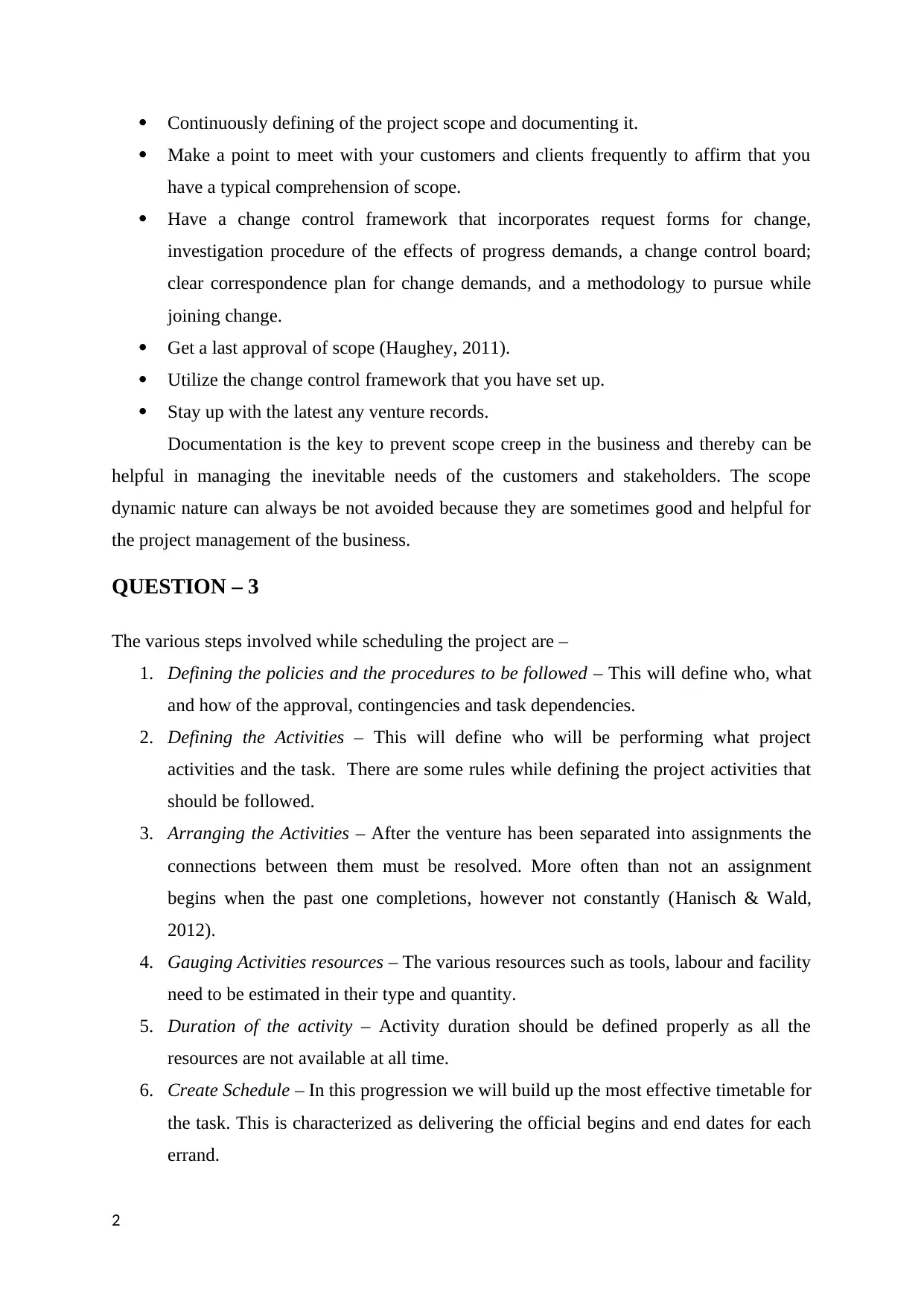
Continuously defining of the project scope and documenting it.
Make a point to meet with your customers and clients frequently to affirm that you
have a typical comprehension of scope.
Have a change control framework that incorporates request forms for change,
investigation procedure of the effects of progress demands, a change control board;
clear correspondence plan for change demands, and a methodology to pursue while
joining change.
Get a last approval of scope (Haughey, 2011).
Utilize the change control framework that you have set up.
Stay up with the latest any venture records.
Documentation is the key to prevent scope creep in the business and thereby can be
helpful in managing the inevitable needs of the customers and stakeholders. The scope
dynamic nature can always be not avoided because they are sometimes good and helpful for
the project management of the business.
QUESTION – 3
The various steps involved while scheduling the project are –
1. Defining the policies and the procedures to be followed – This will define who, what
and how of the approval, contingencies and task dependencies.
2. Defining the Activities – This will define who will be performing what project
activities and the task. There are some rules while defining the project activities that
should be followed.
3. Arranging the Activities – After the venture has been separated into assignments the
connections between them must be resolved. More often than not an assignment
begins when the past one completions, however not constantly (Hanisch & Wald,
2012).
4. Gauging Activities resources – The various resources such as tools, labour and facility
need to be estimated in their type and quantity.
5. Duration of the activity – Activity duration should be defined properly as all the
resources are not available at all time.
6. Create Schedule – In this progression we will build up the most effective timetable for
the task. This is characterized as delivering the official begins and end dates for each
errand.
2
Make a point to meet with your customers and clients frequently to affirm that you
have a typical comprehension of scope.
Have a change control framework that incorporates request forms for change,
investigation procedure of the effects of progress demands, a change control board;
clear correspondence plan for change demands, and a methodology to pursue while
joining change.
Get a last approval of scope (Haughey, 2011).
Utilize the change control framework that you have set up.
Stay up with the latest any venture records.
Documentation is the key to prevent scope creep in the business and thereby can be
helpful in managing the inevitable needs of the customers and stakeholders. The scope
dynamic nature can always be not avoided because they are sometimes good and helpful for
the project management of the business.
QUESTION – 3
The various steps involved while scheduling the project are –
1. Defining the policies and the procedures to be followed – This will define who, what
and how of the approval, contingencies and task dependencies.
2. Defining the Activities – This will define who will be performing what project
activities and the task. There are some rules while defining the project activities that
should be followed.
3. Arranging the Activities – After the venture has been separated into assignments the
connections between them must be resolved. More often than not an assignment
begins when the past one completions, however not constantly (Hanisch & Wald,
2012).
4. Gauging Activities resources – The various resources such as tools, labour and facility
need to be estimated in their type and quantity.
5. Duration of the activity – Activity duration should be defined properly as all the
resources are not available at all time.
6. Create Schedule – In this progression we will build up the most effective timetable for
the task. This is characterized as delivering the official begins and end dates for each
errand.
2
Secure Best Marks with AI Grader
Need help grading? Try our AI Grader for instant feedback on your assignments.
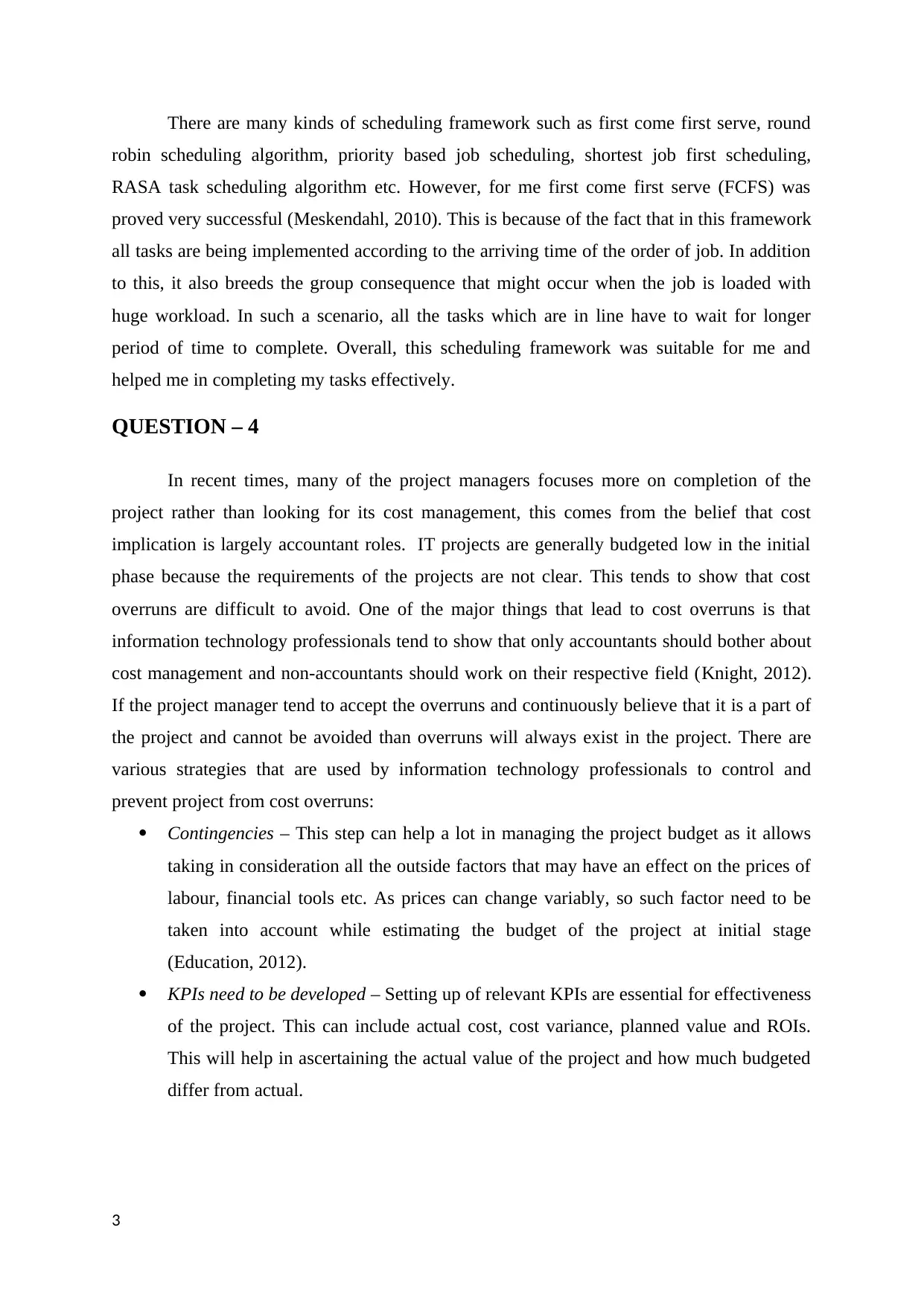
There are many kinds of scheduling framework such as first come first serve, round
robin scheduling algorithm, priority based job scheduling, shortest job first scheduling,
RASA task scheduling algorithm etc. However, for me first come first serve (FCFS) was
proved very successful (Meskendahl, 2010). This is because of the fact that in this framework
all tasks are being implemented according to the arriving time of the order of job. In addition
to this, it also breeds the group consequence that might occur when the job is loaded with
huge workload. In such a scenario, all the tasks which are in line have to wait for longer
period of time to complete. Overall, this scheduling framework was suitable for me and
helped me in completing my tasks effectively.
QUESTION – 4
In recent times, many of the project managers focuses more on completion of the
project rather than looking for its cost management, this comes from the belief that cost
implication is largely accountant roles. IT projects are generally budgeted low in the initial
phase because the requirements of the projects are not clear. This tends to show that cost
overruns are difficult to avoid. One of the major things that lead to cost overruns is that
information technology professionals tend to show that only accountants should bother about
cost management and non-accountants should work on their respective field (Knight, 2012).
If the project manager tend to accept the overruns and continuously believe that it is a part of
the project and cannot be avoided than overruns will always exist in the project. There are
various strategies that are used by information technology professionals to control and
prevent project from cost overruns:
Contingencies – This step can help a lot in managing the project budget as it allows
taking in consideration all the outside factors that may have an effect on the prices of
labour, financial tools etc. As prices can change variably, so such factor need to be
taken into account while estimating the budget of the project at initial stage
(Education, 2012).
KPIs need to be developed – Setting up of relevant KPIs are essential for effectiveness
of the project. This can include actual cost, cost variance, planned value and ROIs.
This will help in ascertaining the actual value of the project and how much budgeted
differ from actual.
3
robin scheduling algorithm, priority based job scheduling, shortest job first scheduling,
RASA task scheduling algorithm etc. However, for me first come first serve (FCFS) was
proved very successful (Meskendahl, 2010). This is because of the fact that in this framework
all tasks are being implemented according to the arriving time of the order of job. In addition
to this, it also breeds the group consequence that might occur when the job is loaded with
huge workload. In such a scenario, all the tasks which are in line have to wait for longer
period of time to complete. Overall, this scheduling framework was suitable for me and
helped me in completing my tasks effectively.
QUESTION – 4
In recent times, many of the project managers focuses more on completion of the
project rather than looking for its cost management, this comes from the belief that cost
implication is largely accountant roles. IT projects are generally budgeted low in the initial
phase because the requirements of the projects are not clear. This tends to show that cost
overruns are difficult to avoid. One of the major things that lead to cost overruns is that
information technology professionals tend to show that only accountants should bother about
cost management and non-accountants should work on their respective field (Knight, 2012).
If the project manager tend to accept the overruns and continuously believe that it is a part of
the project and cannot be avoided than overruns will always exist in the project. There are
various strategies that are used by information technology professionals to control and
prevent project from cost overruns:
Contingencies – This step can help a lot in managing the project budget as it allows
taking in consideration all the outside factors that may have an effect on the prices of
labour, financial tools etc. As prices can change variably, so such factor need to be
taken into account while estimating the budget of the project at initial stage
(Education, 2012).
KPIs need to be developed – Setting up of relevant KPIs are essential for effectiveness
of the project. This can include actual cost, cost variance, planned value and ROIs.
This will help in ascertaining the actual value of the project and how much budgeted
differ from actual.
3
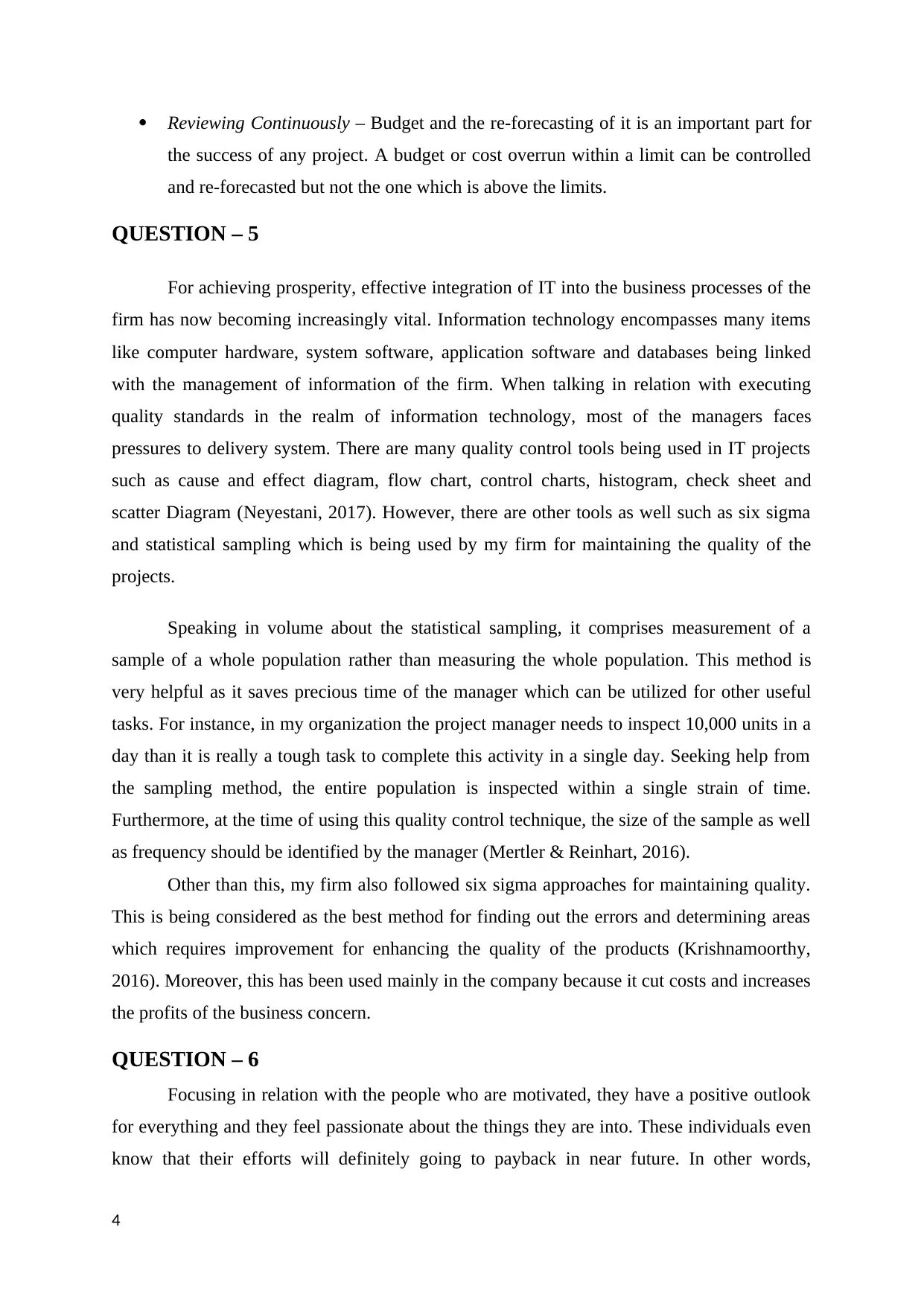
Reviewing Continuously – Budget and the re-forecasting of it is an important part for
the success of any project. A budget or cost overrun within a limit can be controlled
and re-forecasted but not the one which is above the limits.
QUESTION – 5
For achieving prosperity, effective integration of IT into the business processes of the
firm has now becoming increasingly vital. Information technology encompasses many items
like computer hardware, system software, application software and databases being linked
with the management of information of the firm. When talking in relation with executing
quality standards in the realm of information technology, most of the managers faces
pressures to delivery system. There are many quality control tools being used in IT projects
such as cause and effect diagram, flow chart, control charts, histogram, check sheet and
scatter Diagram (Neyestani, 2017). However, there are other tools as well such as six sigma
and statistical sampling which is being used by my firm for maintaining the quality of the
projects.
Speaking in volume about the statistical sampling, it comprises measurement of a
sample of a whole population rather than measuring the whole population. This method is
very helpful as it saves precious time of the manager which can be utilized for other useful
tasks. For instance, in my organization the project manager needs to inspect 10,000 units in a
day than it is really a tough task to complete this activity in a single day. Seeking help from
the sampling method, the entire population is inspected within a single strain of time.
Furthermore, at the time of using this quality control technique, the size of the sample as well
as frequency should be identified by the manager (Mertler & Reinhart, 2016).
Other than this, my firm also followed six sigma approaches for maintaining quality.
This is being considered as the best method for finding out the errors and determining areas
which requires improvement for enhancing the quality of the products (Krishnamoorthy,
2016). Moreover, this has been used mainly in the company because it cut costs and increases
the profits of the business concern.
QUESTION – 6
Focusing in relation with the people who are motivated, they have a positive outlook
for everything and they feel passionate about the things they are into. These individuals even
know that their efforts will definitely going to payback in near future. In other words,
4
the success of any project. A budget or cost overrun within a limit can be controlled
and re-forecasted but not the one which is above the limits.
QUESTION – 5
For achieving prosperity, effective integration of IT into the business processes of the
firm has now becoming increasingly vital. Information technology encompasses many items
like computer hardware, system software, application software and databases being linked
with the management of information of the firm. When talking in relation with executing
quality standards in the realm of information technology, most of the managers faces
pressures to delivery system. There are many quality control tools being used in IT projects
such as cause and effect diagram, flow chart, control charts, histogram, check sheet and
scatter Diagram (Neyestani, 2017). However, there are other tools as well such as six sigma
and statistical sampling which is being used by my firm for maintaining the quality of the
projects.
Speaking in volume about the statistical sampling, it comprises measurement of a
sample of a whole population rather than measuring the whole population. This method is
very helpful as it saves precious time of the manager which can be utilized for other useful
tasks. For instance, in my organization the project manager needs to inspect 10,000 units in a
day than it is really a tough task to complete this activity in a single day. Seeking help from
the sampling method, the entire population is inspected within a single strain of time.
Furthermore, at the time of using this quality control technique, the size of the sample as well
as frequency should be identified by the manager (Mertler & Reinhart, 2016).
Other than this, my firm also followed six sigma approaches for maintaining quality.
This is being considered as the best method for finding out the errors and determining areas
which requires improvement for enhancing the quality of the products (Krishnamoorthy,
2016). Moreover, this has been used mainly in the company because it cut costs and increases
the profits of the business concern.
QUESTION – 6
Focusing in relation with the people who are motivated, they have a positive outlook
for everything and they feel passionate about the things they are into. These individuals even
know that their efforts will definitely going to payback in near future. In other words,
4
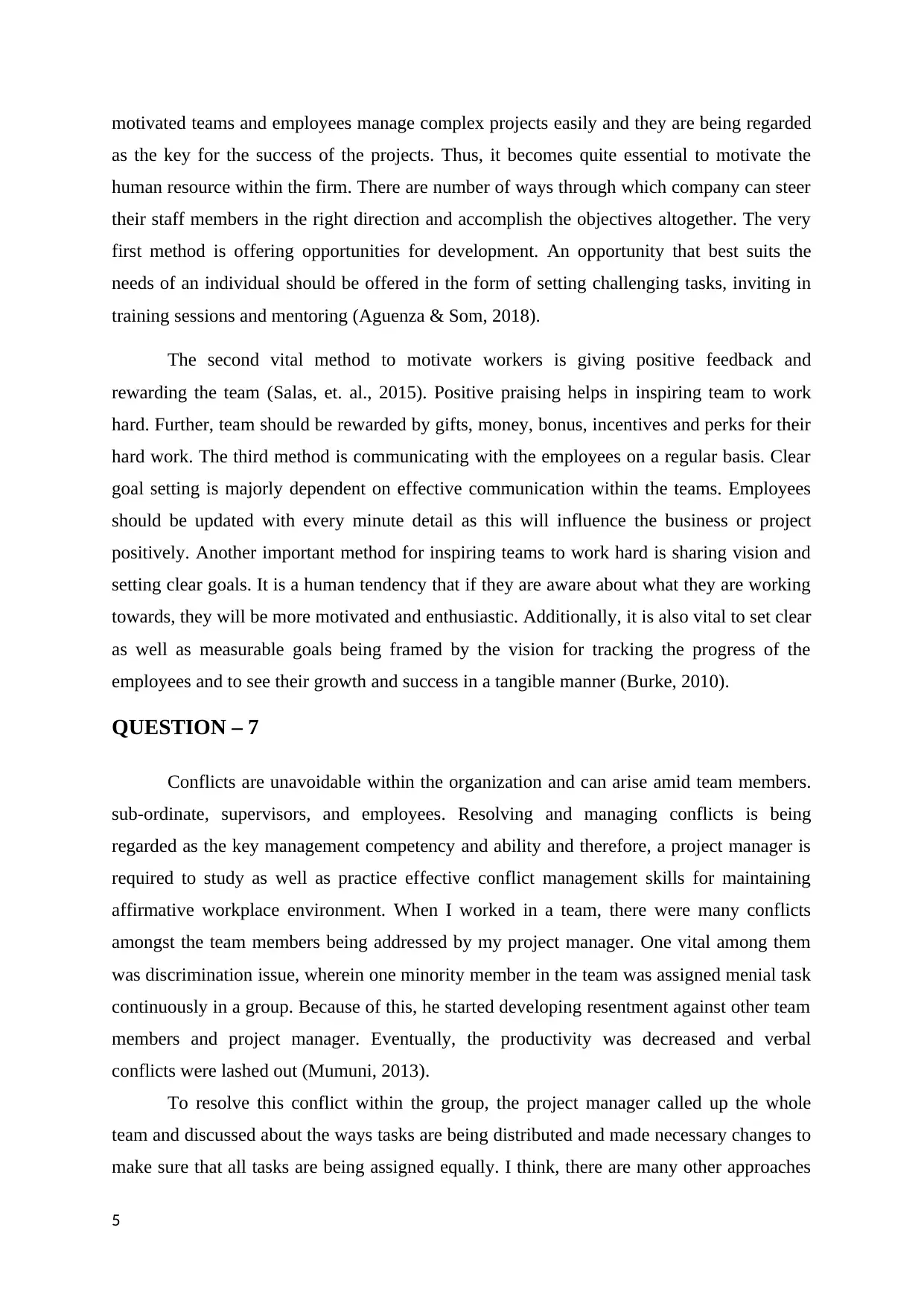
motivated teams and employees manage complex projects easily and they are being regarded
as the key for the success of the projects. Thus, it becomes quite essential to motivate the
human resource within the firm. There are number of ways through which company can steer
their staff members in the right direction and accomplish the objectives altogether. The very
first method is offering opportunities for development. An opportunity that best suits the
needs of an individual should be offered in the form of setting challenging tasks, inviting in
training sessions and mentoring (Aguenza & Som, 2018).
The second vital method to motivate workers is giving positive feedback and
rewarding the team (Salas, et. al., 2015). Positive praising helps in inspiring team to work
hard. Further, team should be rewarded by gifts, money, bonus, incentives and perks for their
hard work. The third method is communicating with the employees on a regular basis. Clear
goal setting is majorly dependent on effective communication within the teams. Employees
should be updated with every minute detail as this will influence the business or project
positively. Another important method for inspiring teams to work hard is sharing vision and
setting clear goals. It is a human tendency that if they are aware about what they are working
towards, they will be more motivated and enthusiastic. Additionally, it is also vital to set clear
as well as measurable goals being framed by the vision for tracking the progress of the
employees and to see their growth and success in a tangible manner (Burke, 2010).
QUESTION – 7
Conflicts are unavoidable within the organization and can arise amid team members.
sub-ordinate, supervisors, and employees. Resolving and managing conflicts is being
regarded as the key management competency and ability and therefore, a project manager is
required to study as well as practice effective conflict management skills for maintaining
affirmative workplace environment. When I worked in a team, there were many conflicts
amongst the team members being addressed by my project manager. One vital among them
was discrimination issue, wherein one minority member in the team was assigned menial task
continuously in a group. Because of this, he started developing resentment against other team
members and project manager. Eventually, the productivity was decreased and verbal
conflicts were lashed out (Mumuni, 2013).
To resolve this conflict within the group, the project manager called up the whole
team and discussed about the ways tasks are being distributed and made necessary changes to
make sure that all tasks are being assigned equally. I think, there are many other approaches
5
as the key for the success of the projects. Thus, it becomes quite essential to motivate the
human resource within the firm. There are number of ways through which company can steer
their staff members in the right direction and accomplish the objectives altogether. The very
first method is offering opportunities for development. An opportunity that best suits the
needs of an individual should be offered in the form of setting challenging tasks, inviting in
training sessions and mentoring (Aguenza & Som, 2018).
The second vital method to motivate workers is giving positive feedback and
rewarding the team (Salas, et. al., 2015). Positive praising helps in inspiring team to work
hard. Further, team should be rewarded by gifts, money, bonus, incentives and perks for their
hard work. The third method is communicating with the employees on a regular basis. Clear
goal setting is majorly dependent on effective communication within the teams. Employees
should be updated with every minute detail as this will influence the business or project
positively. Another important method for inspiring teams to work hard is sharing vision and
setting clear goals. It is a human tendency that if they are aware about what they are working
towards, they will be more motivated and enthusiastic. Additionally, it is also vital to set clear
as well as measurable goals being framed by the vision for tracking the progress of the
employees and to see their growth and success in a tangible manner (Burke, 2010).
QUESTION – 7
Conflicts are unavoidable within the organization and can arise amid team members.
sub-ordinate, supervisors, and employees. Resolving and managing conflicts is being
regarded as the key management competency and ability and therefore, a project manager is
required to study as well as practice effective conflict management skills for maintaining
affirmative workplace environment. When I worked in a team, there were many conflicts
amongst the team members being addressed by my project manager. One vital among them
was discrimination issue, wherein one minority member in the team was assigned menial task
continuously in a group. Because of this, he started developing resentment against other team
members and project manager. Eventually, the productivity was decreased and verbal
conflicts were lashed out (Mumuni, 2013).
To resolve this conflict within the group, the project manager called up the whole
team and discussed about the ways tasks are being distributed and made necessary changes to
make sure that all tasks are being assigned equally. I think, there are many other approaches
5
Paraphrase This Document
Need a fresh take? Get an instant paraphrase of this document with our AI Paraphraser
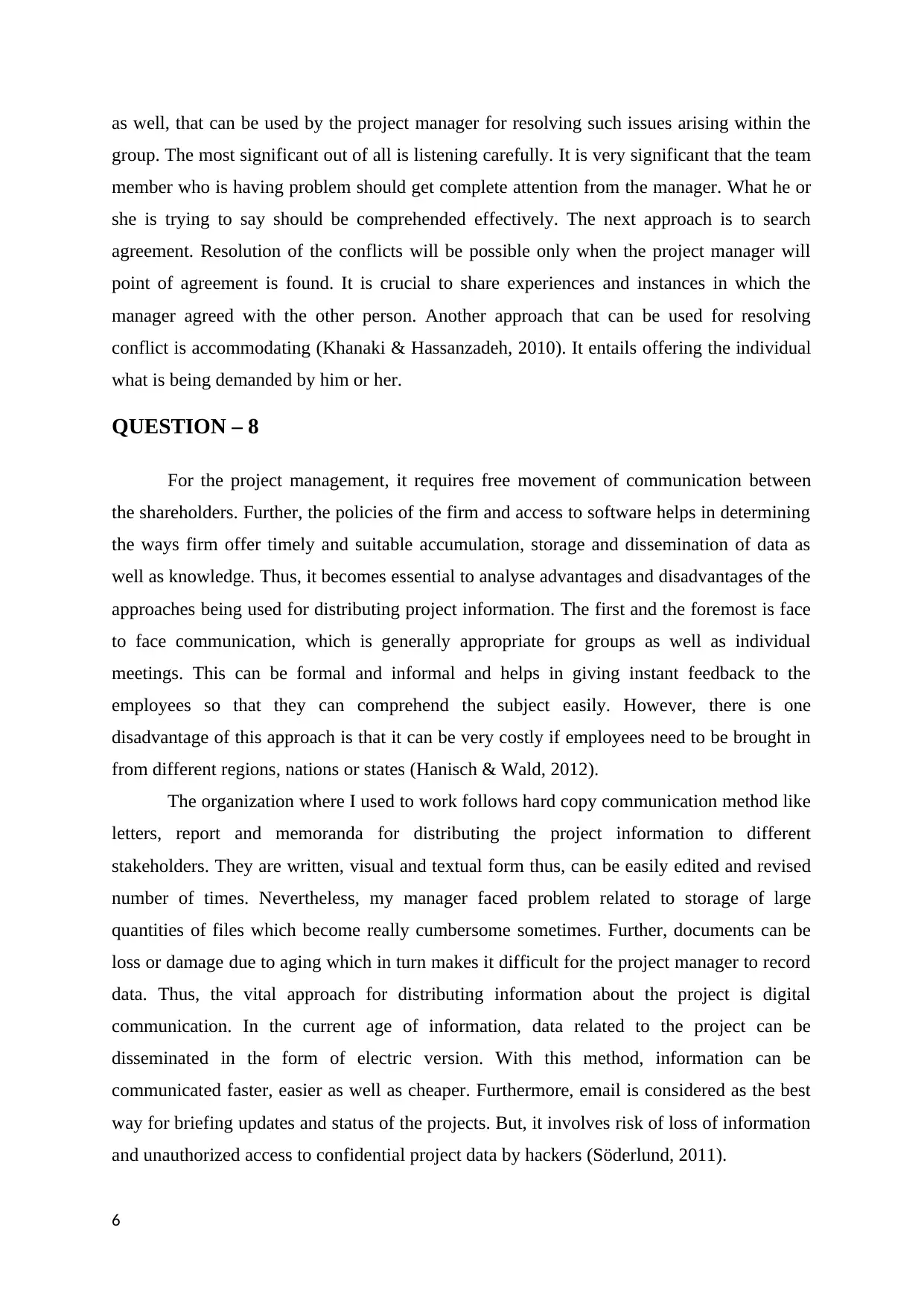
as well, that can be used by the project manager for resolving such issues arising within the
group. The most significant out of all is listening carefully. It is very significant that the team
member who is having problem should get complete attention from the manager. What he or
she is trying to say should be comprehended effectively. The next approach is to search
agreement. Resolution of the conflicts will be possible only when the project manager will
point of agreement is found. It is crucial to share experiences and instances in which the
manager agreed with the other person. Another approach that can be used for resolving
conflict is accommodating (Khanaki & Hassanzadeh, 2010). It entails offering the individual
what is being demanded by him or her.
QUESTION – 8
For the project management, it requires free movement of communication between
the shareholders. Further, the policies of the firm and access to software helps in determining
the ways firm offer timely and suitable accumulation, storage and dissemination of data as
well as knowledge. Thus, it becomes essential to analyse advantages and disadvantages of the
approaches being used for distributing project information. The first and the foremost is face
to face communication, which is generally appropriate for groups as well as individual
meetings. This can be formal and informal and helps in giving instant feedback to the
employees so that they can comprehend the subject easily. However, there is one
disadvantage of this approach is that it can be very costly if employees need to be brought in
from different regions, nations or states (Hanisch & Wald, 2012).
The organization where I used to work follows hard copy communication method like
letters, report and memoranda for distributing the project information to different
stakeholders. They are written, visual and textual form thus, can be easily edited and revised
number of times. Nevertheless, my manager faced problem related to storage of large
quantities of files which become really cumbersome sometimes. Further, documents can be
loss or damage due to aging which in turn makes it difficult for the project manager to record
data. Thus, the vital approach for distributing information about the project is digital
communication. In the current age of information, data related to the project can be
disseminated in the form of electric version. With this method, information can be
communicated faster, easier as well as cheaper. Furthermore, email is considered as the best
way for briefing updates and status of the projects. But, it involves risk of loss of information
and unauthorized access to confidential project data by hackers (Söderlund, 2011).
6
group. The most significant out of all is listening carefully. It is very significant that the team
member who is having problem should get complete attention from the manager. What he or
she is trying to say should be comprehended effectively. The next approach is to search
agreement. Resolution of the conflicts will be possible only when the project manager will
point of agreement is found. It is crucial to share experiences and instances in which the
manager agreed with the other person. Another approach that can be used for resolving
conflict is accommodating (Khanaki & Hassanzadeh, 2010). It entails offering the individual
what is being demanded by him or her.
QUESTION – 8
For the project management, it requires free movement of communication between
the shareholders. Further, the policies of the firm and access to software helps in determining
the ways firm offer timely and suitable accumulation, storage and dissemination of data as
well as knowledge. Thus, it becomes essential to analyse advantages and disadvantages of the
approaches being used for distributing project information. The first and the foremost is face
to face communication, which is generally appropriate for groups as well as individual
meetings. This can be formal and informal and helps in giving instant feedback to the
employees so that they can comprehend the subject easily. However, there is one
disadvantage of this approach is that it can be very costly if employees need to be brought in
from different regions, nations or states (Hanisch & Wald, 2012).
The organization where I used to work follows hard copy communication method like
letters, report and memoranda for distributing the project information to different
stakeholders. They are written, visual and textual form thus, can be easily edited and revised
number of times. Nevertheless, my manager faced problem related to storage of large
quantities of files which become really cumbersome sometimes. Further, documents can be
loss or damage due to aging which in turn makes it difficult for the project manager to record
data. Thus, the vital approach for distributing information about the project is digital
communication. In the current age of information, data related to the project can be
disseminated in the form of electric version. With this method, information can be
communicated faster, easier as well as cheaper. Furthermore, email is considered as the best
way for briefing updates and status of the projects. But, it involves risk of loss of information
and unauthorized access to confidential project data by hackers (Söderlund, 2011).
6
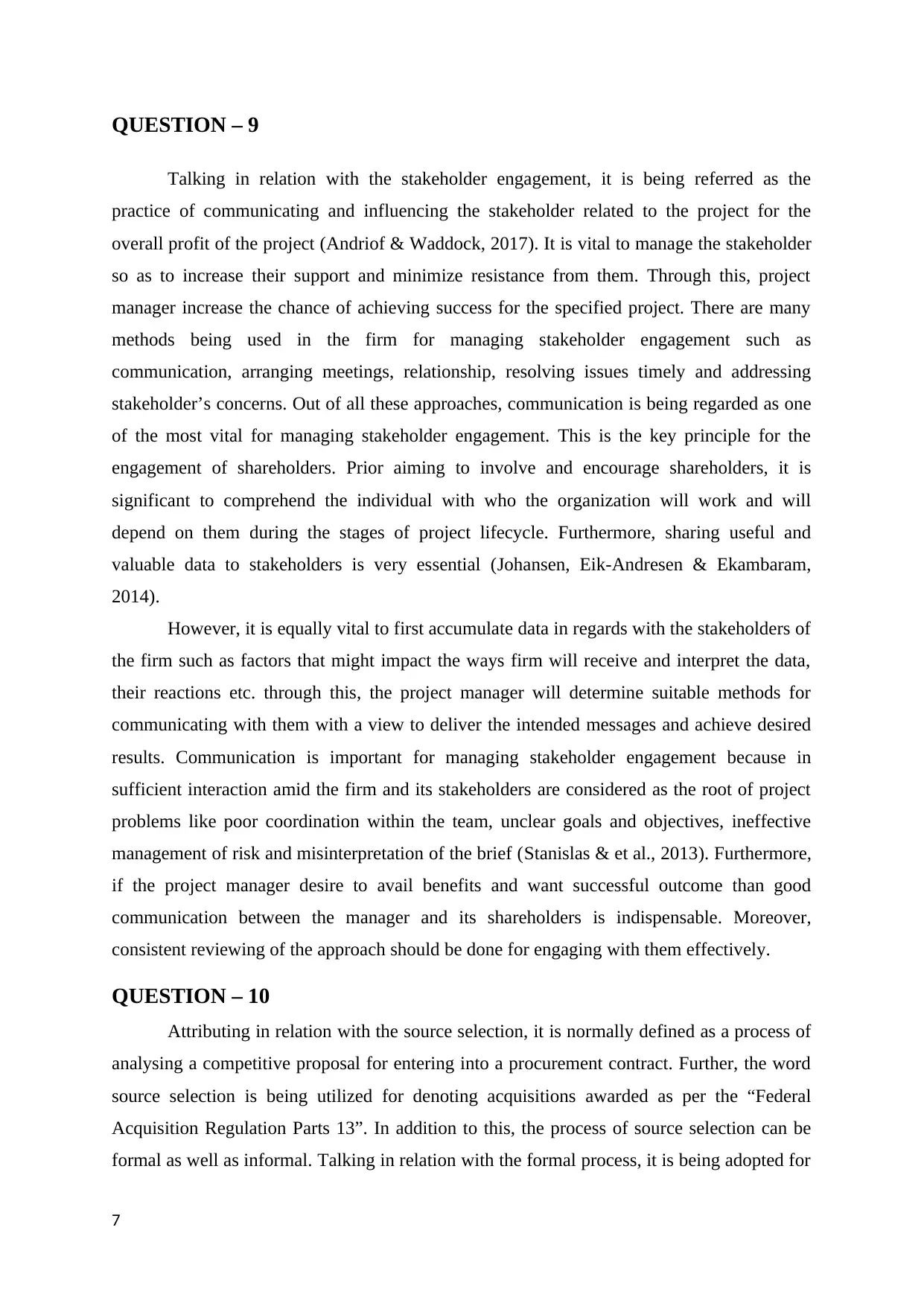
QUESTION – 9
Talking in relation with the stakeholder engagement, it is being referred as the
practice of communicating and influencing the stakeholder related to the project for the
overall profit of the project (Andriof & Waddock, 2017). It is vital to manage the stakeholder
so as to increase their support and minimize resistance from them. Through this, project
manager increase the chance of achieving success for the specified project. There are many
methods being used in the firm for managing stakeholder engagement such as
communication, arranging meetings, relationship, resolving issues timely and addressing
stakeholder’s concerns. Out of all these approaches, communication is being regarded as one
of the most vital for managing stakeholder engagement. This is the key principle for the
engagement of shareholders. Prior aiming to involve and encourage shareholders, it is
significant to comprehend the individual with who the organization will work and will
depend on them during the stages of project lifecycle. Furthermore, sharing useful and
valuable data to stakeholders is very essential (Johansen, Eik-Andresen & Ekambaram,
2014).
However, it is equally vital to first accumulate data in regards with the stakeholders of
the firm such as factors that might impact the ways firm will receive and interpret the data,
their reactions etc. through this, the project manager will determine suitable methods for
communicating with them with a view to deliver the intended messages and achieve desired
results. Communication is important for managing stakeholder engagement because in
sufficient interaction amid the firm and its stakeholders are considered as the root of project
problems like poor coordination within the team, unclear goals and objectives, ineffective
management of risk and misinterpretation of the brief (Stanislas & et al., 2013). Furthermore,
if the project manager desire to avail benefits and want successful outcome than good
communication between the manager and its shareholders is indispensable. Moreover,
consistent reviewing of the approach should be done for engaging with them effectively.
QUESTION – 10
Attributing in relation with the source selection, it is normally defined as a process of
analysing a competitive proposal for entering into a procurement contract. Further, the word
source selection is being utilized for denoting acquisitions awarded as per the “Federal
Acquisition Regulation Parts 13”. In addition to this, the process of source selection can be
formal as well as informal. Talking in relation with the formal process, it is being adopted for
7
Talking in relation with the stakeholder engagement, it is being referred as the
practice of communicating and influencing the stakeholder related to the project for the
overall profit of the project (Andriof & Waddock, 2017). It is vital to manage the stakeholder
so as to increase their support and minimize resistance from them. Through this, project
manager increase the chance of achieving success for the specified project. There are many
methods being used in the firm for managing stakeholder engagement such as
communication, arranging meetings, relationship, resolving issues timely and addressing
stakeholder’s concerns. Out of all these approaches, communication is being regarded as one
of the most vital for managing stakeholder engagement. This is the key principle for the
engagement of shareholders. Prior aiming to involve and encourage shareholders, it is
significant to comprehend the individual with who the organization will work and will
depend on them during the stages of project lifecycle. Furthermore, sharing useful and
valuable data to stakeholders is very essential (Johansen, Eik-Andresen & Ekambaram,
2014).
However, it is equally vital to first accumulate data in regards with the stakeholders of
the firm such as factors that might impact the ways firm will receive and interpret the data,
their reactions etc. through this, the project manager will determine suitable methods for
communicating with them with a view to deliver the intended messages and achieve desired
results. Communication is important for managing stakeholder engagement because in
sufficient interaction amid the firm and its stakeholders are considered as the root of project
problems like poor coordination within the team, unclear goals and objectives, ineffective
management of risk and misinterpretation of the brief (Stanislas & et al., 2013). Furthermore,
if the project manager desire to avail benefits and want successful outcome than good
communication between the manager and its shareholders is indispensable. Moreover,
consistent reviewing of the approach should be done for engaging with them effectively.
QUESTION – 10
Attributing in relation with the source selection, it is normally defined as a process of
analysing a competitive proposal for entering into a procurement contract. Further, the word
source selection is being utilized for denoting acquisitions awarded as per the “Federal
Acquisition Regulation Parts 13”. In addition to this, the process of source selection can be
formal as well as informal. Talking in relation with the formal process, it is being adopted for
7
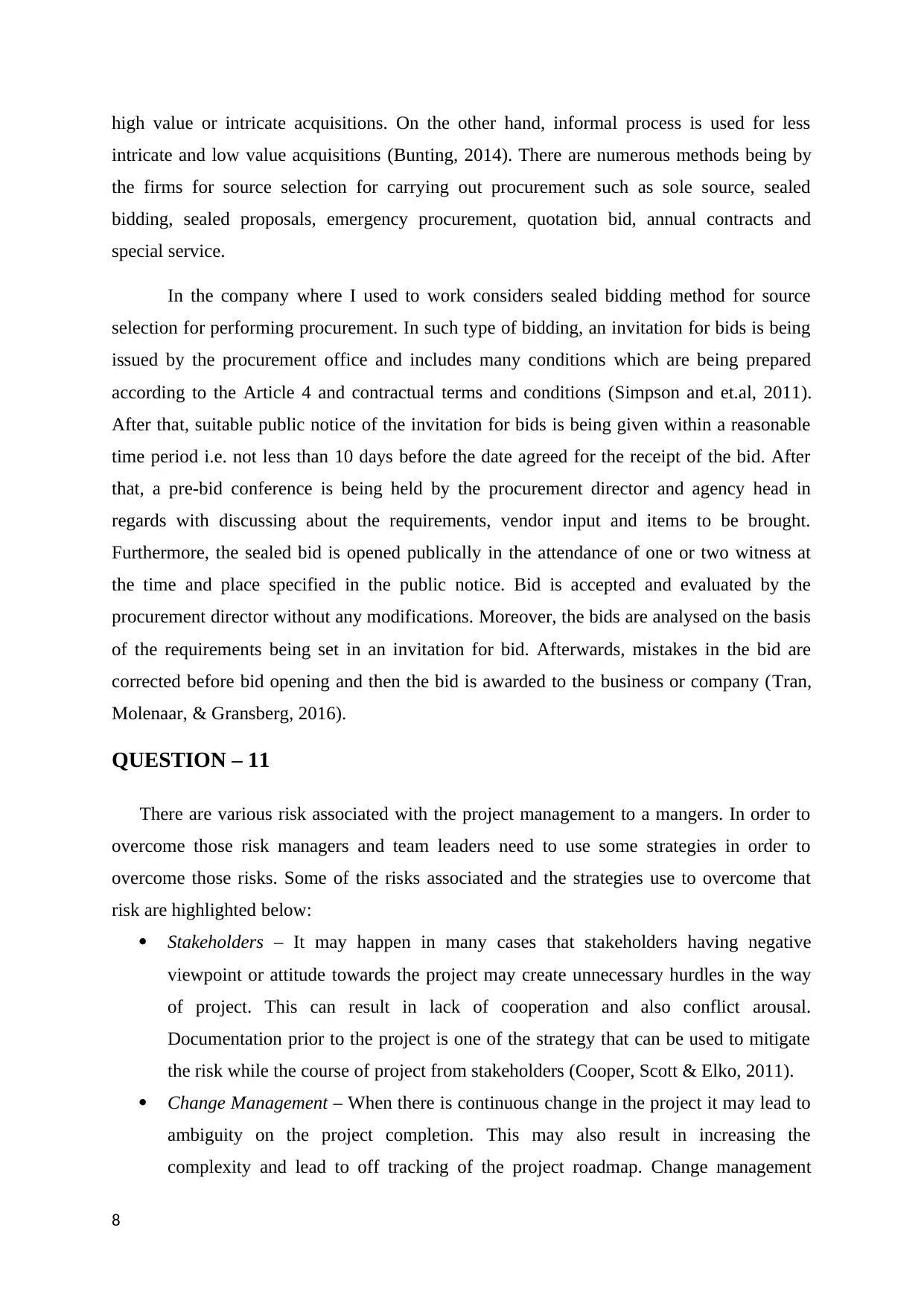
high value or intricate acquisitions. On the other hand, informal process is used for less
intricate and low value acquisitions (Bunting, 2014). There are numerous methods being by
the firms for source selection for carrying out procurement such as sole source, sealed
bidding, sealed proposals, emergency procurement, quotation bid, annual contracts and
special service.
In the company where I used to work considers sealed bidding method for source
selection for performing procurement. In such type of bidding, an invitation for bids is being
issued by the procurement office and includes many conditions which are being prepared
according to the Article 4 and contractual terms and conditions (Simpson and et.al, 2011).
After that, suitable public notice of the invitation for bids is being given within a reasonable
time period i.e. not less than 10 days before the date agreed for the receipt of the bid. After
that, a pre-bid conference is being held by the procurement director and agency head in
regards with discussing about the requirements, vendor input and items to be brought.
Furthermore, the sealed bid is opened publically in the attendance of one or two witness at
the time and place specified in the public notice. Bid is accepted and evaluated by the
procurement director without any modifications. Moreover, the bids are analysed on the basis
of the requirements being set in an invitation for bid. Afterwards, mistakes in the bid are
corrected before bid opening and then the bid is awarded to the business or company (Tran,
Molenaar, & Gransberg, 2016).
QUESTION – 11
There are various risk associated with the project management to a mangers. In order to
overcome those risk managers and team leaders need to use some strategies in order to
overcome those risks. Some of the risks associated and the strategies use to overcome that
risk are highlighted below:
Stakeholders – It may happen in many cases that stakeholders having negative
viewpoint or attitude towards the project may create unnecessary hurdles in the way
of project. This can result in lack of cooperation and also conflict arousal.
Documentation prior to the project is one of the strategy that can be used to mitigate
the risk while the course of project from stakeholders (Cooper, Scott & Elko, 2011).
Change Management – When there is continuous change in the project it may lead to
ambiguity on the project completion. This may also result in increasing the
complexity and lead to off tracking of the project roadmap. Change management
8
intricate and low value acquisitions (Bunting, 2014). There are numerous methods being by
the firms for source selection for carrying out procurement such as sole source, sealed
bidding, sealed proposals, emergency procurement, quotation bid, annual contracts and
special service.
In the company where I used to work considers sealed bidding method for source
selection for performing procurement. In such type of bidding, an invitation for bids is being
issued by the procurement office and includes many conditions which are being prepared
according to the Article 4 and contractual terms and conditions (Simpson and et.al, 2011).
After that, suitable public notice of the invitation for bids is being given within a reasonable
time period i.e. not less than 10 days before the date agreed for the receipt of the bid. After
that, a pre-bid conference is being held by the procurement director and agency head in
regards with discussing about the requirements, vendor input and items to be brought.
Furthermore, the sealed bid is opened publically in the attendance of one or two witness at
the time and place specified in the public notice. Bid is accepted and evaluated by the
procurement director without any modifications. Moreover, the bids are analysed on the basis
of the requirements being set in an invitation for bid. Afterwards, mistakes in the bid are
corrected before bid opening and then the bid is awarded to the business or company (Tran,
Molenaar, & Gransberg, 2016).
QUESTION – 11
There are various risk associated with the project management to a mangers. In order to
overcome those risk managers and team leaders need to use some strategies in order to
overcome those risks. Some of the risks associated and the strategies use to overcome that
risk are highlighted below:
Stakeholders – It may happen in many cases that stakeholders having negative
viewpoint or attitude towards the project may create unnecessary hurdles in the way
of project. This can result in lack of cooperation and also conflict arousal.
Documentation prior to the project is one of the strategy that can be used to mitigate
the risk while the course of project from stakeholders (Cooper, Scott & Elko, 2011).
Change Management – When there is continuous change in the project it may lead to
ambiguity on the project completion. This may also result in increasing the
complexity and lead to off tracking of the project roadmap. Change management
8
Secure Best Marks with AI Grader
Need help grading? Try our AI Grader for instant feedback on your assignments.
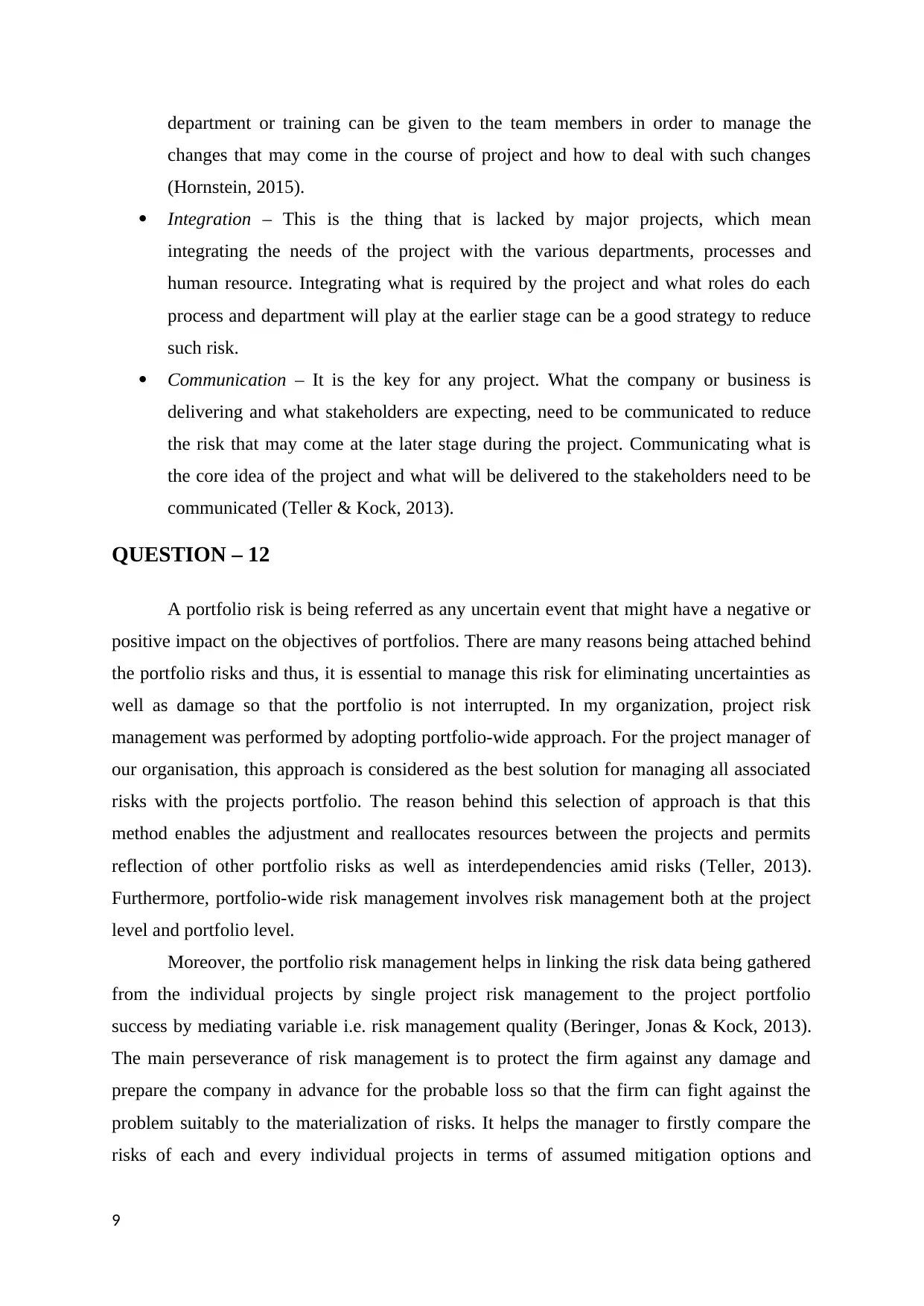
department or training can be given to the team members in order to manage the
changes that may come in the course of project and how to deal with such changes
(Hornstein, 2015).
Integration – This is the thing that is lacked by major projects, which mean
integrating the needs of the project with the various departments, processes and
human resource. Integrating what is required by the project and what roles do each
process and department will play at the earlier stage can be a good strategy to reduce
such risk.
Communication – It is the key for any project. What the company or business is
delivering and what stakeholders are expecting, need to be communicated to reduce
the risk that may come at the later stage during the project. Communicating what is
the core idea of the project and what will be delivered to the stakeholders need to be
communicated (Teller & Kock, 2013).
QUESTION – 12
A portfolio risk is being referred as any uncertain event that might have a negative or
positive impact on the objectives of portfolios. There are many reasons being attached behind
the portfolio risks and thus, it is essential to manage this risk for eliminating uncertainties as
well as damage so that the portfolio is not interrupted. In my organization, project risk
management was performed by adopting portfolio-wide approach. For the project manager of
our organisation, this approach is considered as the best solution for managing all associated
risks with the projects portfolio. The reason behind this selection of approach is that this
method enables the adjustment and reallocates resources between the projects and permits
reflection of other portfolio risks as well as interdependencies amid risks (Teller, 2013).
Furthermore, portfolio-wide risk management involves risk management both at the project
level and portfolio level.
Moreover, the portfolio risk management helps in linking the risk data being gathered
from the individual projects by single project risk management to the project portfolio
success by mediating variable i.e. risk management quality (Beringer, Jonas & Kock, 2013).
The main perseverance of risk management is to protect the firm against any damage and
prepare the company in advance for the probable loss so that the firm can fight against the
problem suitably to the materialization of risks. It helps the manager to firstly compare the
risks of each and every individual projects in terms of assumed mitigation options and
9
changes that may come in the course of project and how to deal with such changes
(Hornstein, 2015).
Integration – This is the thing that is lacked by major projects, which mean
integrating the needs of the project with the various departments, processes and
human resource. Integrating what is required by the project and what roles do each
process and department will play at the earlier stage can be a good strategy to reduce
such risk.
Communication – It is the key for any project. What the company or business is
delivering and what stakeholders are expecting, need to be communicated to reduce
the risk that may come at the later stage during the project. Communicating what is
the core idea of the project and what will be delivered to the stakeholders need to be
communicated (Teller & Kock, 2013).
QUESTION – 12
A portfolio risk is being referred as any uncertain event that might have a negative or
positive impact on the objectives of portfolios. There are many reasons being attached behind
the portfolio risks and thus, it is essential to manage this risk for eliminating uncertainties as
well as damage so that the portfolio is not interrupted. In my organization, project risk
management was performed by adopting portfolio-wide approach. For the project manager of
our organisation, this approach is considered as the best solution for managing all associated
risks with the projects portfolio. The reason behind this selection of approach is that this
method enables the adjustment and reallocates resources between the projects and permits
reflection of other portfolio risks as well as interdependencies amid risks (Teller, 2013).
Furthermore, portfolio-wide risk management involves risk management both at the project
level and portfolio level.
Moreover, the portfolio risk management helps in linking the risk data being gathered
from the individual projects by single project risk management to the project portfolio
success by mediating variable i.e. risk management quality (Beringer, Jonas & Kock, 2013).
The main perseverance of risk management is to protect the firm against any damage and
prepare the company in advance for the probable loss so that the firm can fight against the
problem suitably to the materialization of risks. It helps the manager to firstly compare the
risks of each and every individual projects in terms of assumed mitigation options and
9
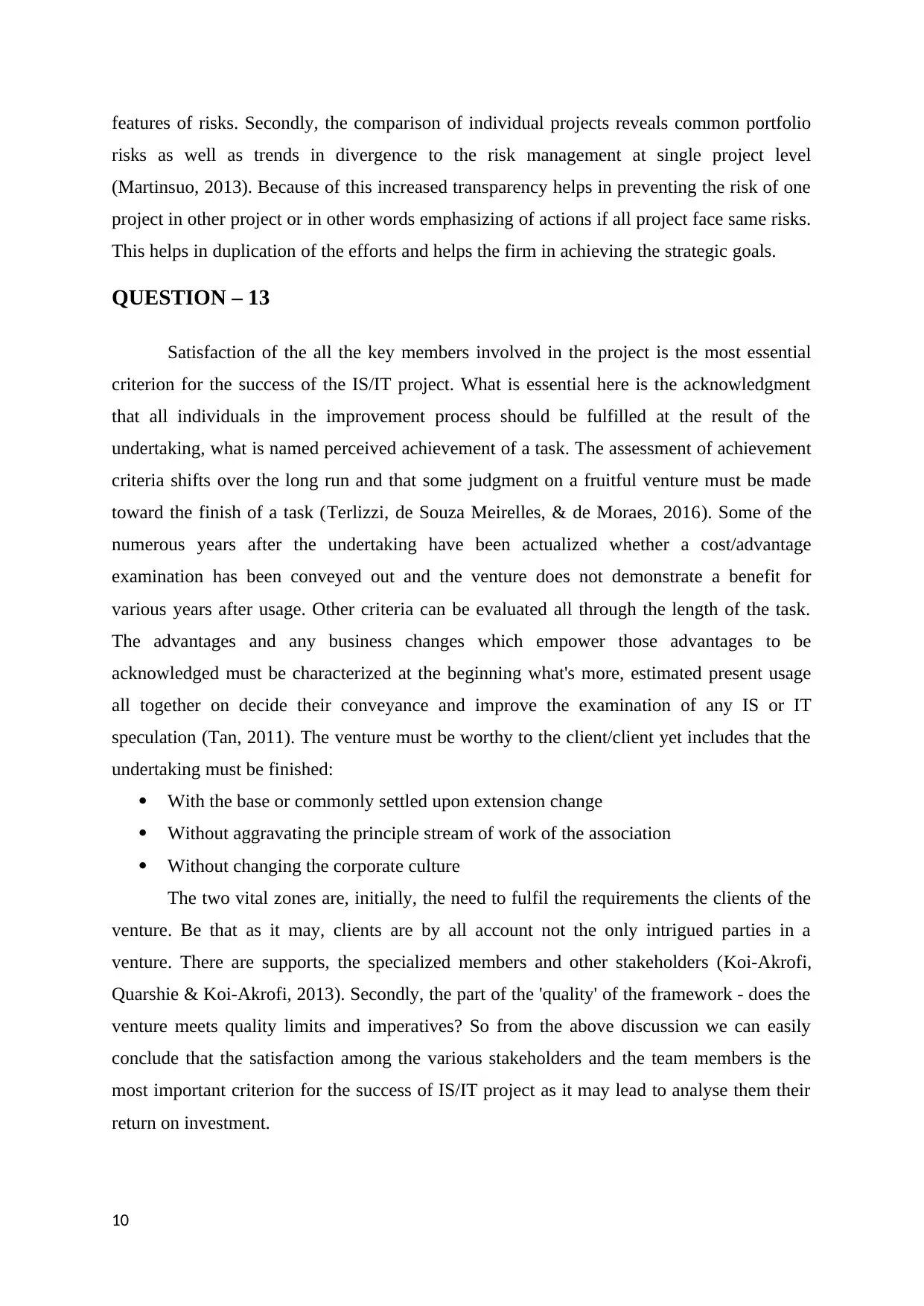
features of risks. Secondly, the comparison of individual projects reveals common portfolio
risks as well as trends in divergence to the risk management at single project level
(Martinsuo, 2013). Because of this increased transparency helps in preventing the risk of one
project in other project or in other words emphasizing of actions if all project face same risks.
This helps in duplication of the efforts and helps the firm in achieving the strategic goals.
QUESTION – 13
Satisfaction of the all the key members involved in the project is the most essential
criterion for the success of the IS/IT project. What is essential here is the acknowledgment
that all individuals in the improvement process should be fulfilled at the result of the
undertaking, what is named perceived achievement of a task. The assessment of achievement
criteria shifts over the long run and that some judgment on a fruitful venture must be made
toward the finish of a task (Terlizzi, de Souza Meirelles, & de Moraes, 2016). Some of the
numerous years after the undertaking have been actualized whether a cost/advantage
examination has been conveyed out and the venture does not demonstrate a benefit for
various years after usage. Other criteria can be evaluated all through the length of the task.
The advantages and any business changes which empower those advantages to be
acknowledged must be characterized at the beginning what's more, estimated present usage
all together on decide their conveyance and improve the examination of any IS or IT
speculation (Tan, 2011). The venture must be worthy to the client/client yet includes that the
undertaking must be finished:
With the base or commonly settled upon extension change
Without aggravating the principle stream of work of the association
Without changing the corporate culture
The two vital zones are, initially, the need to fulfil the requirements the clients of the
venture. Be that as it may, clients are by all account not the only intrigued parties in a
venture. There are supports, the specialized members and other stakeholders (Koi-Akrofi,
Quarshie & Koi-Akrofi, 2013). Secondly, the part of the 'quality' of the framework - does the
venture meets quality limits and imperatives? So from the above discussion we can easily
conclude that the satisfaction among the various stakeholders and the team members is the
most important criterion for the success of IS/IT project as it may lead to analyse them their
return on investment.
10
risks as well as trends in divergence to the risk management at single project level
(Martinsuo, 2013). Because of this increased transparency helps in preventing the risk of one
project in other project or in other words emphasizing of actions if all project face same risks.
This helps in duplication of the efforts and helps the firm in achieving the strategic goals.
QUESTION – 13
Satisfaction of the all the key members involved in the project is the most essential
criterion for the success of the IS/IT project. What is essential here is the acknowledgment
that all individuals in the improvement process should be fulfilled at the result of the
undertaking, what is named perceived achievement of a task. The assessment of achievement
criteria shifts over the long run and that some judgment on a fruitful venture must be made
toward the finish of a task (Terlizzi, de Souza Meirelles, & de Moraes, 2016). Some of the
numerous years after the undertaking have been actualized whether a cost/advantage
examination has been conveyed out and the venture does not demonstrate a benefit for
various years after usage. Other criteria can be evaluated all through the length of the task.
The advantages and any business changes which empower those advantages to be
acknowledged must be characterized at the beginning what's more, estimated present usage
all together on decide their conveyance and improve the examination of any IS or IT
speculation (Tan, 2011). The venture must be worthy to the client/client yet includes that the
undertaking must be finished:
With the base or commonly settled upon extension change
Without aggravating the principle stream of work of the association
Without changing the corporate culture
The two vital zones are, initially, the need to fulfil the requirements the clients of the
venture. Be that as it may, clients are by all account not the only intrigued parties in a
venture. There are supports, the specialized members and other stakeholders (Koi-Akrofi,
Quarshie & Koi-Akrofi, 2013). Secondly, the part of the 'quality' of the framework - does the
venture meets quality limits and imperatives? So from the above discussion we can easily
conclude that the satisfaction among the various stakeholders and the team members is the
most important criterion for the success of IS/IT project as it may lead to analyse them their
return on investment.
10
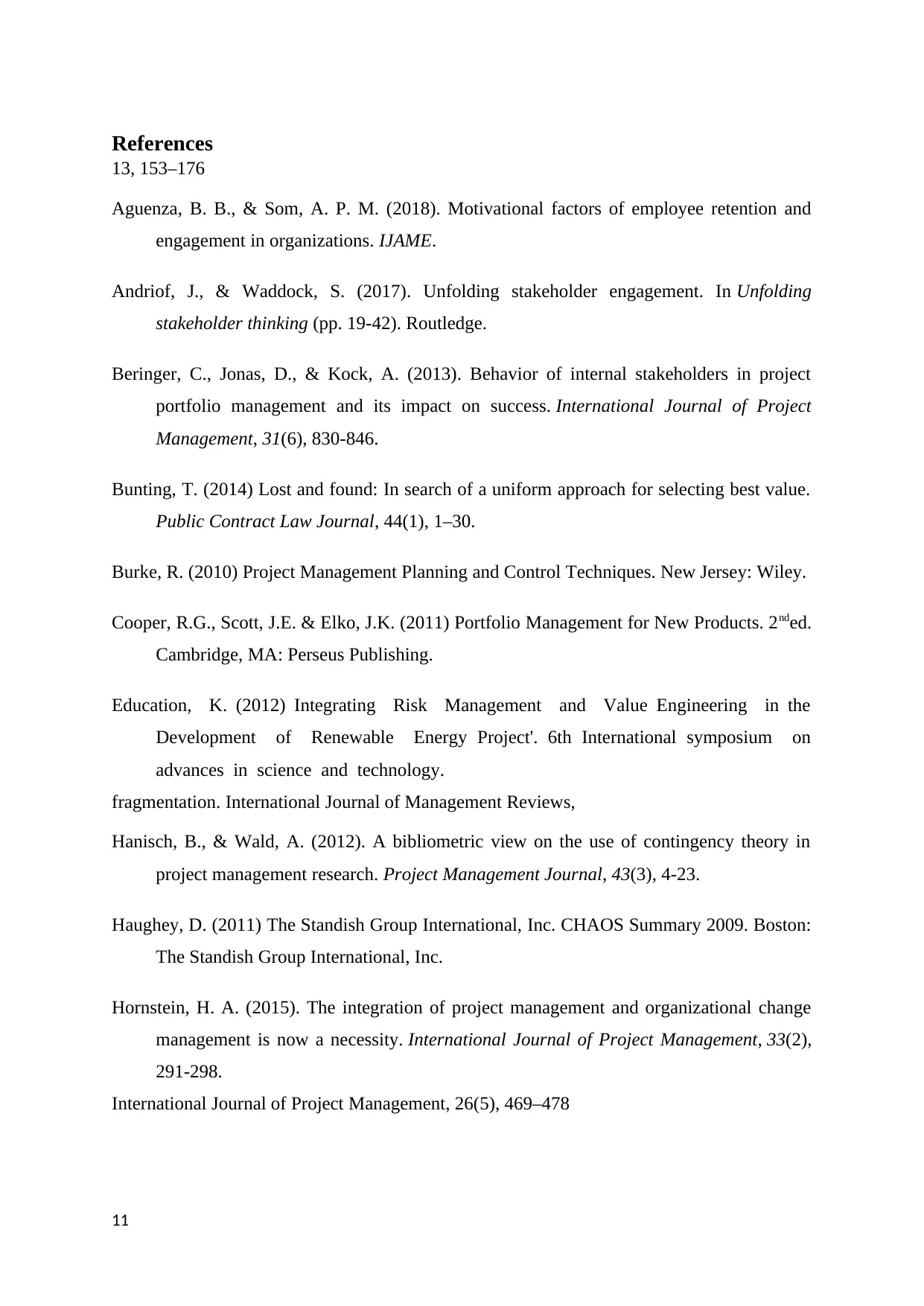
References
13, 153–176
Aguenza, B. B., & Som, A. P. M. (2018). Motivational factors of employee retention and
engagement in organizations. IJAME.
Andriof, J., & Waddock, S. (2017). Unfolding stakeholder engagement. In Unfolding
stakeholder thinking (pp. 19-42). Routledge.
Beringer, C., Jonas, D., & Kock, A. (2013). Behavior of internal stakeholders in project
portfolio management and its impact on success. International Journal of Project
Management, 31(6), 830-846.
Bunting, T. (2014) Lost and found: In search of a uniform approach for selecting best value.
Public Contract Law Journal, 44(1), 1–30.
Burke, R. (2010) Project Management Planning and Control Techniques. New Jersey: Wiley.
Cooper, R.G., Scott, J.E. & Elko, J.K. (2011) Portfolio Management for New Products. 2nded.
Cambridge, MA: Perseus Publishing.
Education, K. (2012) Integrating Risk Management and Value Engineering in the
Development of Renewable Energy Project'. 6th International symposium on
advances in science and technology.
fragmentation. International Journal of Management Reviews,
Hanisch, B., & Wald, A. (2012). A bibliometric view on the use of contingency theory in
project management research. Project Management Journal, 43(3), 4-23.
Haughey, D. (2011) The Standish Group International, Inc. CHAOS Summary 2009. Boston:
The Standish Group International, Inc.
Hornstein, H. A. (2015). The integration of project management and organizational change
management is now a necessity. International Journal of Project Management, 33(2),
291-298.
International Journal of Project Management, 26(5), 469–478
11
13, 153–176
Aguenza, B. B., & Som, A. P. M. (2018). Motivational factors of employee retention and
engagement in organizations. IJAME.
Andriof, J., & Waddock, S. (2017). Unfolding stakeholder engagement. In Unfolding
stakeholder thinking (pp. 19-42). Routledge.
Beringer, C., Jonas, D., & Kock, A. (2013). Behavior of internal stakeholders in project
portfolio management and its impact on success. International Journal of Project
Management, 31(6), 830-846.
Bunting, T. (2014) Lost and found: In search of a uniform approach for selecting best value.
Public Contract Law Journal, 44(1), 1–30.
Burke, R. (2010) Project Management Planning and Control Techniques. New Jersey: Wiley.
Cooper, R.G., Scott, J.E. & Elko, J.K. (2011) Portfolio Management for New Products. 2nded.
Cambridge, MA: Perseus Publishing.
Education, K. (2012) Integrating Risk Management and Value Engineering in the
Development of Renewable Energy Project'. 6th International symposium on
advances in science and technology.
fragmentation. International Journal of Management Reviews,
Hanisch, B., & Wald, A. (2012). A bibliometric view on the use of contingency theory in
project management research. Project Management Journal, 43(3), 4-23.
Haughey, D. (2011) The Standish Group International, Inc. CHAOS Summary 2009. Boston:
The Standish Group International, Inc.
Hornstein, H. A. (2015). The integration of project management and organizational change
management is now a necessity. International Journal of Project Management, 33(2),
291-298.
International Journal of Project Management, 26(5), 469–478
11
Paraphrase This Document
Need a fresh take? Get an instant paraphrase of this document with our AI Paraphraser
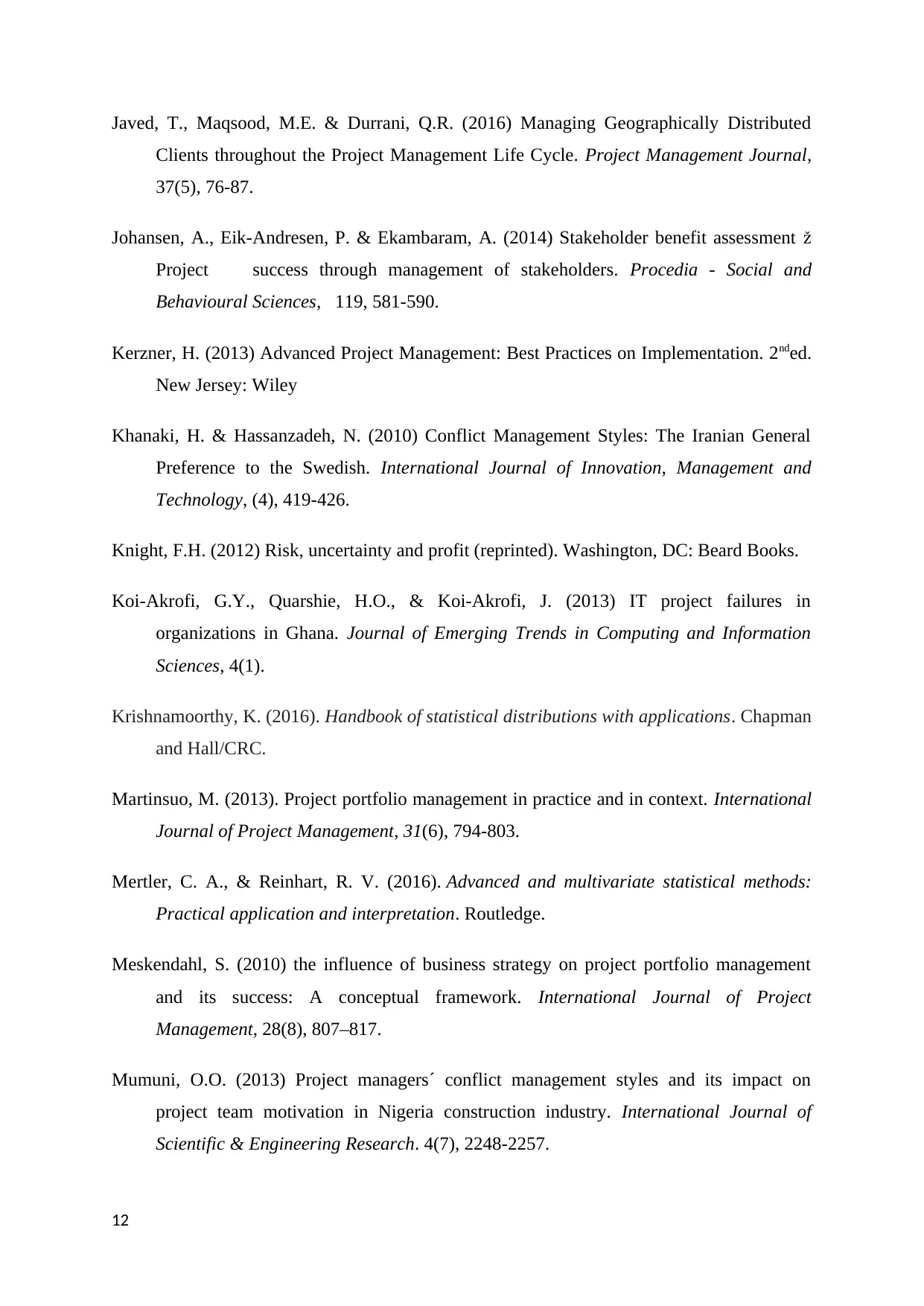
Javed, T., Maqsood, M.E. & Durrani, Q.R. (2016) Managing Geographically Distributed
Clients throughout the Project Management Life Cycle. Project Management Journal,
37(5), 76-87.
Johansen, A., Eik-Andresen, P. & Ekambaram, A. (2014) Stakeholder benefit assessment
Project success through management of stakeholders. Procedia - Social and
Behavioural Sciences, 119, 581-590.
Kerzner, H. (2013) Advanced Project Management: Best Practices on Implementation. 2nded.
New Jersey: Wiley
Khanaki, H. & Hassanzadeh, N. (2010) Conflict Management Styles: The Iranian General
Preference to the Swedish. International Journal of Innovation, Management and
Technology, (4), 419-426.
Knight, F.H. (2012) Risk, uncertainty and profit (reprinted). Washington, DC: Beard Books.
Koi-Akrofi, G.Y., Quarshie, H.O., & Koi-Akrofi, J. (2013) IT project failures in
organizations in Ghana. Journal of Emerging Trends in Computing and Information
Sciences, 4(1).
Krishnamoorthy, K. (2016). Handbook of statistical distributions with applications. Chapman
and Hall/CRC.
Martinsuo, M. (2013). Project portfolio management in practice and in context. International
Journal of Project Management, 31(6), 794-803.
Mertler, C. A., & Reinhart, R. V. (2016). Advanced and multivariate statistical methods:
Practical application and interpretation. Routledge.
Meskendahl, S. (2010) the influence of business strategy on project portfolio management
and its success: A conceptual framework. International Journal of Project
Management, 28(8), 807–817.
Mumuni, O.O. (2013) Project managers´ conflict management styles and its impact on
project team motivation in Nigeria construction industry. International Journal of
Scientific & Engineering Research. 4(7), 2248-2257.
12
Clients throughout the Project Management Life Cycle. Project Management Journal,
37(5), 76-87.
Johansen, A., Eik-Andresen, P. & Ekambaram, A. (2014) Stakeholder benefit assessment
Project success through management of stakeholders. Procedia - Social and
Behavioural Sciences, 119, 581-590.
Kerzner, H. (2013) Advanced Project Management: Best Practices on Implementation. 2nded.
New Jersey: Wiley
Khanaki, H. & Hassanzadeh, N. (2010) Conflict Management Styles: The Iranian General
Preference to the Swedish. International Journal of Innovation, Management and
Technology, (4), 419-426.
Knight, F.H. (2012) Risk, uncertainty and profit (reprinted). Washington, DC: Beard Books.
Koi-Akrofi, G.Y., Quarshie, H.O., & Koi-Akrofi, J. (2013) IT project failures in
organizations in Ghana. Journal of Emerging Trends in Computing and Information
Sciences, 4(1).
Krishnamoorthy, K. (2016). Handbook of statistical distributions with applications. Chapman
and Hall/CRC.
Martinsuo, M. (2013). Project portfolio management in practice and in context. International
Journal of Project Management, 31(6), 794-803.
Mertler, C. A., & Reinhart, R. V. (2016). Advanced and multivariate statistical methods:
Practical application and interpretation. Routledge.
Meskendahl, S. (2010) the influence of business strategy on project portfolio management
and its success: A conceptual framework. International Journal of Project
Management, 28(8), 807–817.
Mumuni, O.O. (2013) Project managers´ conflict management styles and its impact on
project team motivation in Nigeria construction industry. International Journal of
Scientific & Engineering Research. 4(7), 2248-2257.
12
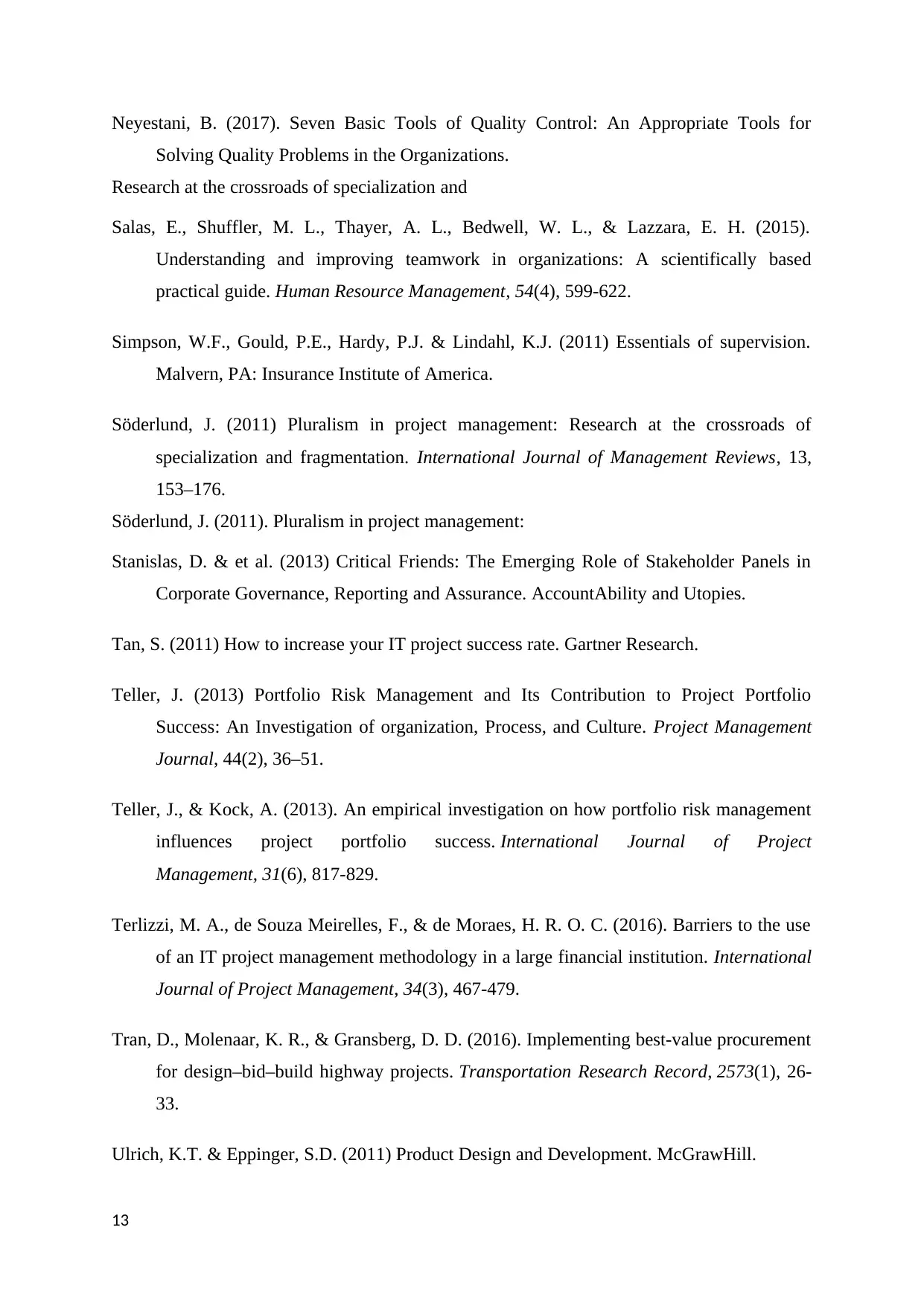
Neyestani, B. (2017). Seven Basic Tools of Quality Control: An Appropriate Tools for
Solving Quality Problems in the Organizations.
Research at the crossroads of specialization and
Salas, E., Shuffler, M. L., Thayer, A. L., Bedwell, W. L., & Lazzara, E. H. (2015).
Understanding and improving teamwork in organizations: A scientifically based
practical guide. Human Resource Management, 54(4), 599-622.
Simpson, W.F., Gould, P.E., Hardy, P.J. & Lindahl, K.J. (2011) Essentials of supervision.
Malvern, PA: Insurance Institute of America.
Söderlund, J. (2011) Pluralism in project management: Research at the crossroads of
specialization and fragmentation. International Journal of Management Reviews, 13,
153–176.
Söderlund, J. (2011). Pluralism in project management:
Stanislas, D. & et al. (2013) Critical Friends: The Emerging Role of Stakeholder Panels in
Corporate Governance, Reporting and Assurance. AccountAbility and Utopies.
Tan, S. (2011) How to increase your IT project success rate. Gartner Research.
Teller, J. (2013) Portfolio Risk Management and Its Contribution to Project Portfolio
Success: An Investigation of organization, Process, and Culture. Project Management
Journal, 44(2), 36–51.
Teller, J., & Kock, A. (2013). An empirical investigation on how portfolio risk management
influences project portfolio success. International Journal of Project
Management, 31(6), 817-829.
Terlizzi, M. A., de Souza Meirelles, F., & de Moraes, H. R. O. C. (2016). Barriers to the use
of an IT project management methodology in a large financial institution. International
Journal of Project Management, 34(3), 467-479.
Tran, D., Molenaar, K. R., & Gransberg, D. D. (2016). Implementing best-value procurement
for design–bid–build highway projects. Transportation Research Record, 2573(1), 26-
33.
Ulrich, K.T. & Eppinger, S.D. (2011) Product Design and Development. McGrawHill.
13
Solving Quality Problems in the Organizations.
Research at the crossroads of specialization and
Salas, E., Shuffler, M. L., Thayer, A. L., Bedwell, W. L., & Lazzara, E. H. (2015).
Understanding and improving teamwork in organizations: A scientifically based
practical guide. Human Resource Management, 54(4), 599-622.
Simpson, W.F., Gould, P.E., Hardy, P.J. & Lindahl, K.J. (2011) Essentials of supervision.
Malvern, PA: Insurance Institute of America.
Söderlund, J. (2011) Pluralism in project management: Research at the crossroads of
specialization and fragmentation. International Journal of Management Reviews, 13,
153–176.
Söderlund, J. (2011). Pluralism in project management:
Stanislas, D. & et al. (2013) Critical Friends: The Emerging Role of Stakeholder Panels in
Corporate Governance, Reporting and Assurance. AccountAbility and Utopies.
Tan, S. (2011) How to increase your IT project success rate. Gartner Research.
Teller, J. (2013) Portfolio Risk Management and Its Contribution to Project Portfolio
Success: An Investigation of organization, Process, and Culture. Project Management
Journal, 44(2), 36–51.
Teller, J., & Kock, A. (2013). An empirical investigation on how portfolio risk management
influences project portfolio success. International Journal of Project
Management, 31(6), 817-829.
Terlizzi, M. A., de Souza Meirelles, F., & de Moraes, H. R. O. C. (2016). Barriers to the use
of an IT project management methodology in a large financial institution. International
Journal of Project Management, 34(3), 467-479.
Tran, D., Molenaar, K. R., & Gransberg, D. D. (2016). Implementing best-value procurement
for design–bid–build highway projects. Transportation Research Record, 2573(1), 26-
33.
Ulrich, K.T. & Eppinger, S.D. (2011) Product Design and Development. McGrawHill.
13
1 out of 15
Related Documents
Your All-in-One AI-Powered Toolkit for Academic Success.
+13062052269
info@desklib.com
Available 24*7 on WhatsApp / Email
![[object Object]](/_next/static/media/star-bottom.7253800d.svg)
Unlock your academic potential
© 2024 | Zucol Services PVT LTD | All rights reserved.





